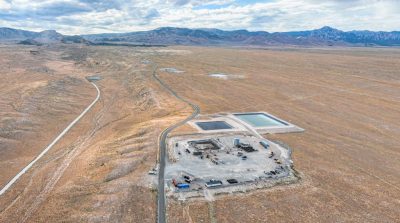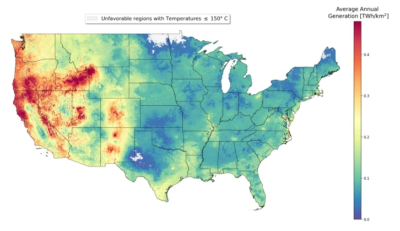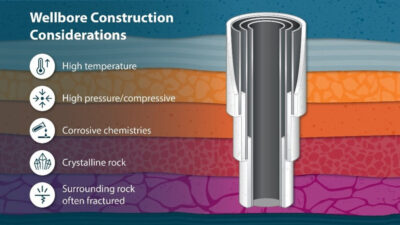Almacenamiento de calor estacional con concepto de batería geotérmica – workshop en línea – 19 de mayo de 2020
Invitación para el workshop - webinar acerca del almacenamiento de energía solar termal en un reservorio geotérmico sintético, que se realizará el 19 de Mayo 2020.
NSF y la Universidad de Utah están invitando a un taller virtual sobre “Almacenamiento de calor solar estacional subsuperficial a gran escala para obtener un valor futuro”, como parte del concepto de almacenamiento de energía de batería geotérmica.
- Fecha y hora: 19 de mayo de 2020 – 10:00 a.m. a 2:30 p.m. MDT a través de Zoom
- Se requiere preinscripción: envíe un correo electrónico a [email protected] y se enviará una invitación
El concepto de almacenamiento de energía de batería geotérmica (“GB”) se ha propuesto como un método de almacenamiento de energía renovable a gran escala. Esto es particularmente importante ya que la electricidad solar y eólica se están introduciendo en las redes eléctricas. Y, el almacenamiento económico a escala de servicios públicos aún no está disponible para manejar la naturaleza variable de la energía solar y eólica.
El concepto utiliza la radiación solar para calentar el agua en la superficie y luego inyectar esta agua caliente profundamente en la tierra. Esta agua caliente crea un depósito geotérmico de alta temperatura aceptable para la producción de electricidad geotérmica convencional o para aplicaciones de calor directo. Almacenar agua caliente bajo tierra no es una idea nueva, pero la característica única del GB es considerar regiones en cuencas sedimentarias con formaciones saturadas de agua de alta porosidad y permeabilidad. Para ciertos reservorios, los cálculos sugieren que casi el 100% del calor almacenado se puede recuperar prácticamente, y que a largo plazo incluso el almacenamiento estacional es posible.
Los autores han presentado varias publicaciones sobre GB considerando las variaciones de los parámetros del yacimiento. Esta es una revisión de los cálculos realizados y las conclusiones para un sistema GB inferido de los cálculos. Se observa la disposición potencial del sistema GB de pozos y las posibilidades de inyección y producción y la recuperación final del calor por valor económico.
________________________
Agenda
- 10:00 am Introduction – John McLennan & Sidney Green
- 10:15 am Heat and Fluid Flow Calculations – Palash Panja & John McLennan
- 11:00 am Operational Considerations and Well Layouts – John McLennan
- 11:30 am Challenges of Sedimentary Basins – Richard Allis
- 12:00 pm 15-minute Break – Brief Recess
- 12:15 pm Site Potential from an Oil & Gas Industry Perspective – Richard Newhart
- 12:45 pm Geochemical Considerations – Joe Moore
- 1:15 pm Surface Facilities – Kevin Kitz
- 1:45 pm Facilitated Discussion and Summary – Sidney Green
About the Presenters
Dr. John McLennan is a USTAR Professor, in the Dept. of Chemical Engineering at the University of Utah. He had nearly thirty years working in industry prior to joining academia in 2008, and is an ARMA Fellow.
Sidney Green is founder/president Enhanced Production, Inc. in Salt Lake City, Utah and a Research Professor, at the University of Utah. He is a founder and past president of TerraTek, acquired by Schlumberger in 2006. He is an ARMA Fellow and member of the US National Academy of Engineering.
Dr. Palash Panja is a Research Scientist at the Energy & Geoscience Institute and an Instructor in the Dept. Chemical Engineering, Univ. of Utah. He has over ten years of research experience and five years of industrial experience.
Dr. Richard Allis is retired as the Director of the Utah Geological Survey and Utah State Geologist. He has worked extensively on geothermal energy in the US, New Zealand, and other countries. He is a licensed Professional Geologist in Utah.
Richard Newhart is a retired VP of Encana Energy. He has forty years’ experience with exploration and production for oil and gas in various basins throughout the US. His background is in geology and play characterization.
Dr. Joseph Moore holds appointments as a Research Professor in the Department of Civil and Environmental Engineering and as an Adjunct Professor in the Department of Geology and Geophysics at the Univ. of Utah. His research has focused on the geology and geochemistry of geothermal systems. He currently serves as the Managing Principal Investigator of Utah’s Frontier Observatory for Research in Geothermal Energy (FORGE), a U.S. Department of Energy initiative to develop Enhanced Geothermal Systems.
Kevin Kitz is a Professional Engineer and founder/owner of KitzWorks, LLC. He has worked in geothermal development, renewable energy, and waste heat recovery for over thirty years in the US and other countries.SolarStorage_geothermal_Workshop_May2020
Acknowledgments
The Workshop is sponsored by the National Science Foundation via EAGER grant Award 1912670 to the University of Utah, with Professor John McLennan as the PI. Thanks are extended to the Idaho National Laboratory for early work on thermal heat storage referred to as GeoTES, in which some of the authors participated. The contributions and support of Peter Smeallie and Gen Green are appreciated.
Fuente: Workshop invitation by email (pdf) / ThinkGeoEnergy


















